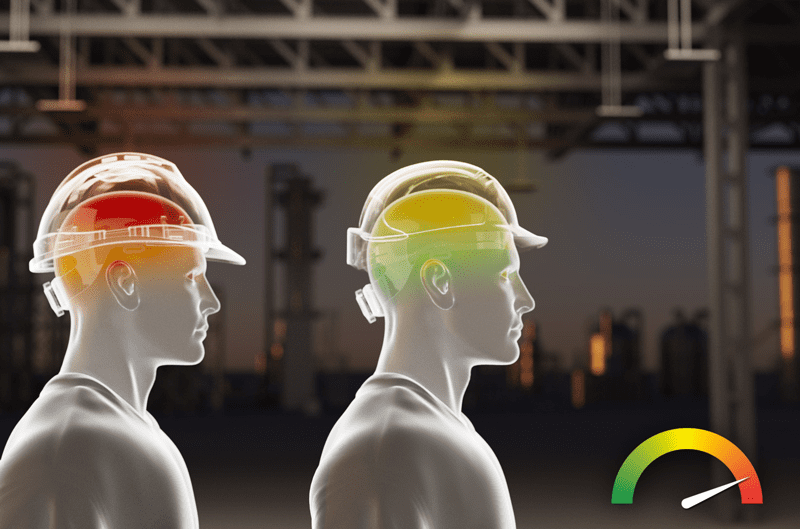The industrial sector is continually seeking to improve the safety of its workers. Despite price and convenience, budget off-the-shelf hard hats and helmets are outdated and don’t address the modern needs of the industrial workforce, ultimately creating productivity and safety issues for individuals and companies alike. Leading product companies in this sector are optimizing the worker experience through human-centered design, a critical move for brands as they invest in innovation for next generation products. By gathering and understanding end user needs, manufacturers are now armed with knowledge to engineer helmets that seamlessly balance protection, comfort, and compliance. New materials and innovations enable helmets to be lighter, more compact, and more comfortable while still meeting rigorous impact standards.
Creating personal protective equipment that workers want to wear – and aren’t tempted to remove – starts with human-centered design. Considering the user experience when engineering personal protective equipment leads to products that reduce the likelihood for short-term removal of safety helmets by workers while supporting all-day wearability and comfort. Every detail of the helmet should be evaluated and optimized for protection, functionality, weight, stability, ventilation, comfort and aesthetic appeal.
The Importance of Addressing Pain Points
It’s critical to understand the pain points workers experience with traditional hard hats. Features that may seem like minor design elements can become major annoyances over long shifts or in hot environments. For example, suspension systems that put pressure on the forehead quickly lead to headaches. Excessive heat buildup can cause heat stress, heat-related injuries or even fatalities. Unbalanced hard hats with high centers of gravity could strain the neck and shoulders. These types of pain points directly impact worker performance, safety and morale. The ultimate goal of human-centered design is eliminating these flaws through empathetic engineering focused on addressing unmet end user needs.
Key Features of Next Generation Helmets
Since its invention in 1919, little has changed with the traditional hard hat. Most are only rated to protect the head from falling objects. However, the demand, needs and risks of workers in the modern world have changed dramatically, and so must their PPE. What exactly sets newer industrial helmets apart? Here are some of the latest features and enhancements workers can expect from advanced head protection systems:
Lower Ride Height – A helmet with a lower ride height improves stability on the head. This can be a crucial design element for wearers working in inverted positions, keeping the helmet on the head when protection is needed most. Lower profile designs with streamlined edges also minimize the potential for snagging or knocking the helmet through lower clearance, improving access and moveability in tight spaces and giving workers the freedom and peace of mind to get the job done.
Lightweight – Advancements in materials enable lighter weight hard hats without compromising safety. Reduced mass could decrease strain on the neck and shoulders over long shifts, ultimately reducing the risk of musculoskeletal disorders (MSDs).
Enhanced Protection with No Compromise on Comfort – Advanced impact materials like KOROYD can provide higher protection without adding weight, bulk or insulation.
Ventilation – Strategically placed vents and breathable impact protection materials prevent heat and moisture buildup. Channeling airflow keeps workers cool and comfortable.
Easy On/Off – Quick-release wheel or slip ratchet systems allow fast, tool-free adjustment for simple donning and doffing. Suspensions with padded front sweatband prevent pressure points.
Removable Accessories – Integrated clips and slots support adding/removing optional eye shields, face shields, ear defenders, lights and other accessories as needed for extended protection.
Next Generation Materials
Advancements in materials science have opened new possibilities for optimized construction in helmet design. KOROYD, a global leader in advanced impact technology, is one such company leading the way in material developments that provide an ideal balance of protection, ventilation, style and human-centric design.
KOROYD material is engineered with a unique tubular construction that absorbs impacts more efficiently than traditional EPS foam liners by crumpling consistently to reduce forces transferred to the head. KOROYD advanced impact technology outperforms EPS, absorbing energy through 80 percent of the material thickness.
The unique open cell structure of KOROYD, which is 95 percent air, enhances air circulation and evaporation of sweat vapor and liquid. Recent testing shows a reduction in heat index of up to 8°F/4.5°C in KOROYD-integrated safety helmets compared to traditional EPS helmets. KOROYD is proven to help maintain cooler body temperatures to prevent heat stress risks, while also reducing potential for short-term removal on the jobsite that can occur on warmer days.
Additionally, KOROYD excels at reducing energy transfer, meaning less material thickness is required to absorb impacts and increase protection. This allows construction of slimmer, low profile helmet designs without compromising safety. Helmets with integrated KOROYD can be designed with an overall reduction in ride height, profile and weight, reducing wearer fatigue and increasing product adoption.
Leading Edge Examples
Several leading manufacturers utilize KOROYD and other innovations to create next generation helmets. Here are a few top options worth considering:
Caco America LLC, a division of GE, recently announced the launch of the new GH400 Type 1 safety helmet. The first helmet to be engineered with KOROYD technology as the sole energy absorber, the GH400 maximizes KOROYD’s patented impact absorption setting a new standard in industrial head protection and further safeguarding employee health and minimizing injury risk caused by rising temperatures on the job site.
The first full-brim Type II safety helmet, the SHK-1 Full Brim, was also released this year by STUDSON, in the pursuit of creating the safest and most technologically advanced industrial safety helmet in the market. Designed to prevent traumatic brain injuries (TBIs), the SHK-1 Full Brim features technologies to support falls and impact-related injuries on any jobsite, including KOROYD material that crumples and absorbs energy upon impact. Additionally, KOROYD improves heat dissipation and venting via its cellular-structure design, helping combat the dangers of heat stress.
Safety Matters
The best PPE solutions balance safety with comfort, providing a wearer experience that reduces short-term removal and increases product adoption. Next generation PPE, like KOROYD-integrated safety helmets, enable high performance protection without compromising the user experience. With innovation in materials and human-centered designs, new head protection solutions allow leading companies to equip their employees with cutting-edge PPE, sending a clear message that worker safety matters.
Headline photo courtesy of KOROYD.
Chris Ellerby, has worked in PPE/RPE for 20 years in product leadership and development roles, currently serving as Director of Industrial Safety atKOROYD, a global leader in advanced impact protection technology.
Oil and gas operations are commonly found in remote locations far from company headquarters. Now, it's possible to monitor pump operations, collate and analyze seismic data, and track employees around the world from almost anywhere. Whether employees are in the office or in the field, the internet and related applications enable a greater multidirectional flow of information – and control – than ever before.




